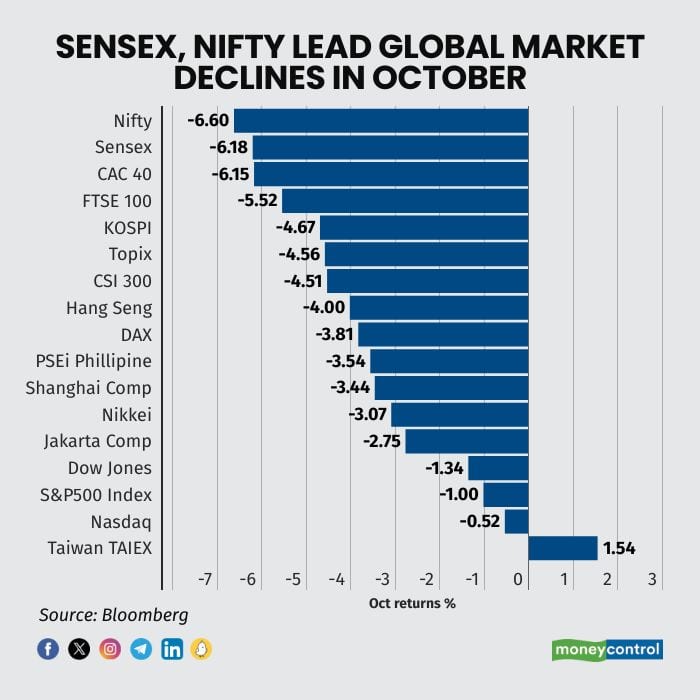



India's benchmark indices, Sensex and Nifty, posted the sharpest declines among major global markets in October, driven by substantial foreign outflows amid heightened geopolitical tensions. Sensex dropped 6.2 percent, while Nifty fell 6.6 percent in dollar terms, marking the steepest losses compared to other key indices.
Globally, markets corrected in response to similar geopolitical tensions, uncertainties surrounding the US election, and anticipation over the Federal Reserve’s rate decisions.
In the US, the Dow Jones slipped 1.34 percent, while the S&P 500 and Nasdaq fell 1 percent and 0.5 percent, respectively. In Europe, the UK's FTSE 100 declined 5.52 percent, France’s CAC 40 dropped 6.1 percent, and Germany’s DAX fell 3.8 percent.
Asian markets followed suit, with Japan's Nikkei down 3 percent, Hong Kong's Hang Seng 4 percent lower, and China’s Shanghai Composite down 3.44 percent. Taiwan's TAIEX gained 1.5 percent, while South Korea's KOSPI fell 4.7 percent, the Philippines’ PSEi declined 3.5 percent, TOPIX lost 4.6 percent, and Indonesia's Jakarta Composite Index slipped 2.8 percent.

Global markets, meanwhile, are reeling from a rise in US bond yields. Despite the Federal Reserve’s 50-basis-point rate cut in September, the US 10-year bond yield has climbed from 3.6 percent to 4.3 percent, raising capital costs for foreign investors in emerging markets. This rate hike has led to concerns over the impact of further rate cuts, which were initially expected to total 300 basis points this year. So far, only a single 50-basis-point cut has materialized, though hopes remain for additional 25-basis-point cuts in November and December.
Indian markets saw heavy foreign institutional investor (FII) selling, totaling over Rs 1 lakh crore in October. Apurva Sheth, Head of Market Perspectives & Research at SAMCO Securities, noted that the US presidential election and its outcome are also impacting FPI activity outside US markets. India Inc’s Q2 results added further pressure on the markets.
As FPIs navigate US developments and bond yields stabilize, their selling activity is expected to remain high, influencing the outlook for Indian and other emerging markets, Sheth added.
An Emkay Global report highlighted that the correction in Indian equities was largely driven by a sharp downgrade in FY2025 earnings per share (EPS) forecasts. Bloomberg data revealed a 13 percent drop in Nifty's EPS estimates for October, with nearly half of Nifty companies experiencing EPS cuts exceeding 1 percent.
Several factors are raising questions about India’s market direction, say analysts. Are domestic challenges like upcoming state elections and adverse weather exerting more pressure than external factors like rising commodity prices? While domestic buying remains steady, foreign investor selling has intensified the downtrend. Urban consumption remains soft, with modest improvements in rural areas, and finance sector concerns persist.
Discover the latest Business News, Sensex, and Nifty updates. Obtain Personal Finance insights, tax queries, and expert opinions on Moneycontrol or download the Moneycontrol App to stay updated!
Find the best of Al News in one place, specially curated for you every weekend.
Stay on top of the latest tech trends and biggest startup news.